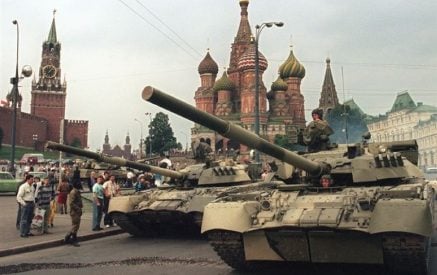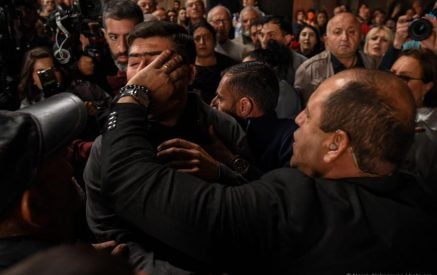Few would be surprised to hear that the United States is involved in supporting a democratic nation that was recently invaded by its authoritarian neighbor. But many Americans are likely unaware that their country is doing so for two such post-Soviet nations: not just Ukraine, but also Armenia, which has been suffering from Azerbaijan’s invasion for almost three weeks now.
The two situations are not unrelated. A key factor behind the ongoing U.S. engagement in Armenia is Russia’s visible absence in a region that the latter considers its backyard. But the U.S. isn’t simply trying to push Russia out from the post-Soviet South Caucasus. Rather, Washington seems to have realized just how serious the threat is—not just for Armenia, but for the world.
In the early minutes of Sept. 13, as families across eastern Armenia slept, Azerbaijan launched the unprovoked shelling of three dozen Armenian towns with heavy artillery and unmanned combat drones. The two countries have been locked in off-and-on hostilities for decades over the disputed Nagorno-Karabakh republic, but Azerbaijan’s regime now seems to take advantage of its rival’s military unpreparedness and global, especially Russian, distraction. Azerbaijan attempted to deny having attacked within Armenia’s borders, but the onslaught was so intense that NASA’s fire-management satellites detected massive thermal anomalies. In just two days, Azerbaijan’s forces killed over 200 Armenians, primarily soldiers, according to official government counts. Videos spread by the invaders appeared to show them giggling while mutilating fallen Armenian women, and executing Armenian soldiers who had surrendered.
Read also
Further details of the incursion came via Armenia-based journalists and officials alike. On Sept. 14, foreign journalists reported having come under Azerbaijani shelling in the Armenian town of Sotk, which is nowhere near military installations. The following day, at the United Nations Security Council emergency hearing, Armenia disclosed that, despite the prior day’s ceasefire, Azerbaijan is amassing additional troops, including in Nakhichevan, Azerbaijan’s exclave bordering southwest Armenia. This would open a second invasion front. On Sept. 23, Western embassies in Yerevan issued still-active “travel warnings” for southern Armenia and beyond, insinuating that they expected further attacks. Still, many media outlets across the world lack on-the-ground regional journalists, so the news from Armenia largely stayed off the mainstream radar.
It was not until U.S. House Speaker Nancy Pelosi’s visit to Armenia the weekend of Sept. 17, in support of Armenian “security and democracy” against Azerbaijan’s “illegal and deadly attacks,” that it became fully clear that the U.S., in a dramatic transformation, is fully engaged, albeit probably only diplomatically, in preventing existential threats against Armenia.
Jackie Speier, one of the two Armenian-American Congresswomen to accompany Speaker Pelosi, recalled at a large Armenian-American gathering in Los Angeles on Sept. 25 that in Armenia she told their dinner host, the Prime Minister, that she didn’t want another girl to feel the way she did growing up: reluctant to identify as Armenian because her homeland, then part of the USSR, did not appear on a world’s map. As the Congresswoman announced at the gathering, she is introducing a resolution in condemnation of and accountability for Azerbaijan’s war crimes and aggression, following a similar motion by prominent House Democrat Adam Schiff, and a bipartisan Senate resolution introduced by key Senators Bob Menendez and Marco Rubio. But this is not about internal electoral politics.
More significantly—especially as Congress has been historically attentive to Armenian American constituency concerns—the White House has now transformed its traditionally “both-sidist” rhetoric on the conflict. It was the U.S., not the regional hegemon Russia, that played the key role in halting Azerbaijan’s Sept. 13-14 aggression. Since then, the Biden Administration has initiated numerous meetings for and with Armenian and Azerbaijani officials, both in person and on the phone, despite threats by Azerbaijan’s authoritarian president—who has made Armenophobia his power-consolidation formula since inheriting the presidency in 2003—that “no one and nothing can stop us.”
U.S. engagement may also come as a surprise given that Armenia is formally part of CSTO (Collective Security Treaty Organization), Russia’s failed mini-version of NATO. Preoccupied with its failing invasion of Ukraine and forced mobilization of troops, Russia is both unable and unwilling to defend its treaty ally Armenia today. But in 2020 and 2021, during previous rounds of aggression by Azerbaijan, Russia likewise chose not to do more to defend its ally, despite having had the military might to do so. On paper, Russia is democratic Armenia’s security guarantor. In reality, Russia and Azerbaijan, two fossil fuel-rich authoritarian states, are much closer; the unwavering support for the latter by Turkey, which has become an ever-more important partner for Russia given western sanctions, complicates Russia’s support for Armenia even more.
Today, the U.S. appears to realize that a preoccupied Russia’s temporary absence in the Caucasus means potential involvement from not just Turkey but also Iran, which has warned against border changes; it has a northern border with Armenia, a secure lifeline to Europe. A potential Turkey-Iran confrontation resulting from Azerbaijan’s invasion of Armenia could result in an unmanageable destabilization of the Middle East and beyond, something that neither Russia nor the U.S. want.
The U.S.’s recent involvement in the Caucasus is unprecedented. For the very first time since the Cold War, it’s the actions of a country other than Russia that matter most right now in the region. Will Washington succeed in preventing a full-scale invasion of democratic Armenia? Is it willing to make sacrifices to meet that goal, such as selling defense weaponry to Armenia and sanctioning Azerbaijan, despite intense Turkish pressure and European energy needs? The only public American sacrifice over the last three weeks in defense of Armenian existence appears to have come from the outgoing U.S. Ambassador to Armenia. On Sept. 28, Lynne Tracy risked her safety to travel to Syunik, Armenia’s southmost region, despite her own embassy’s travel warning against visiting the entire region.
Earlier, President Joe Biden announced that he would nominate Tracy to serve as U.S. ambassador to Russia, a testament to her courage and to the necessity of a deeper understanding of Moscow through those who are most dependent on it. Perhaps Washington realizes that if it fails to thwart Azerbaijan’s next aggression, it will leave Armenia with no choice but to further integrate with Russia. Similar circumstances a century ago, in the aftermath of the Armenian Genocide, helped to revive the collapsed Russian empire into the USSR.
With the possibility of further violence hanging over their talks, the foreign ministers of Armenia and Azerbaijan met in Geneva on Oct. 2, as Azerbaijani special forces reportedly neared Armenia’s borders. Hostilities may resume any moment, given that Azerbaijan’s autocrat seems to have few reasons for restraint. At the Oct. 1 unveiling of a new gas pipeline to Europe, E.U. leader Ursula von der Leyen praised Azerbaijan as “reliable”; Europe, facing the energy impacts of its determination to punish Russia, appears willing to embolden another authoritarian aggressor. The U.S., at least in rhetoric, seems to be slightly more cautious.
Whether the history—of unrealized western promises pushing a vulnerable Armenia closer to Russia—will repeat itself, this time as a cruel joke, largely depends on where American leadership goes next.

























































